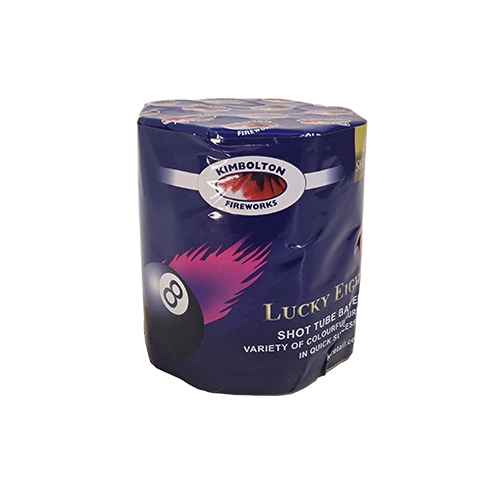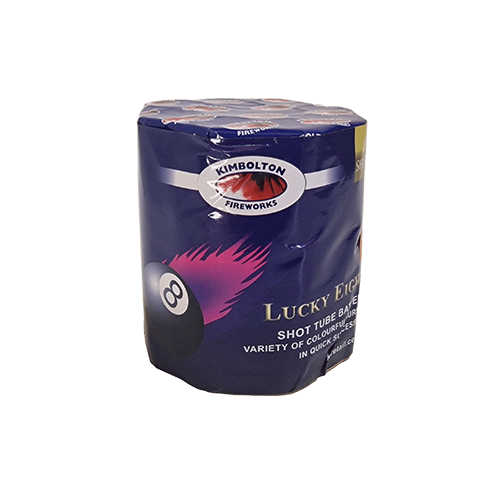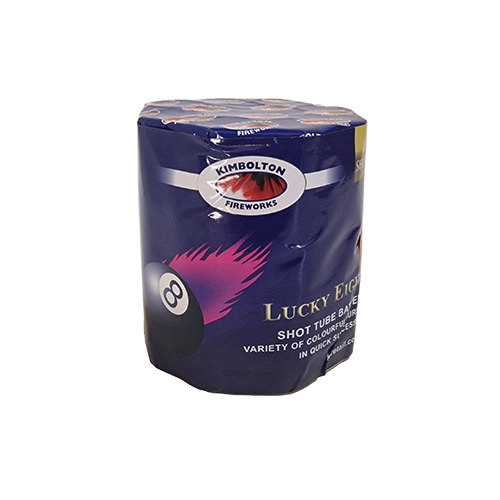

8 shot 25mm calibre Cake
A great small cake that packs a punch for its size.
Effects include
- Brocade to red
- Red and green strobe
- Green strobe with coconut core
- Fireworks Brand :- Kimbolton Fireworks
- Fireworks Safety Distance :- 8 Metres
- Fireworks Shots :- 8 shots
- Fireworks Calibre :- 25mm
- Fireworks Firing Pattern :- Straight
- Fireworks Duration :- 20 seconds
- Fireworks Noise Level :- Medium - 96 to 105db
- Fireworks Class :- F2
- Fireworks Pieces :- 1 pcs
- Fireworks Hazard Type :- 1.4G
- Fireworks NEQ :- 200g
- Fireworks Weight :- 0.67kg
Due to the 'hand-built' nature of fireworks the duration, effects and visuals can vary from batch to batch and from item to item.
Explosive materials are erratic by nature and perform differently depending on environmental conditions at the time of firing.
Set-up & firing for Cakes, Single Ignitions & Compounds
Follow the directions as instructed on the fireworks warning label. Please be aware of the required safety distances for firers and spectators.
Step 1 - Place firework on flat ground and secure to a stake or post which has been inserted in to the ground (crowd side of the cake/barrage) with strong tape or cable ties.

Step 2 - Locate 1st fuse, signified by the words FUSE or FIRST FUSE or by the number 1. (Note: Some fireworks now contain 2 fuses others only have 1)

Step 3 - Remove the orange fuse cover and if required pull fuse through clear plastic on top of the cake for easier access.
Step 4 - Ensuring no part of your body is over the firework. Standing sideways, at arm’s length light outermost end of the fuse and retire immediately to the stated distance on the firework label.
Further Advice
Caged Fireworks
Sometimes the Cake will be caged in a metal mesh with metal straps. Be extremely careful cutting the straps and mesh. Use gloves and a strong pair of snips.
(This is sometimes done to move a powerful cake from a high hazard class 1.3G to a lower class 1.4G so that it can be stored in a 1.4G licensed storage facility.)

Wet Weather
You can wrap your Cakes, Single Ignitions & Compounds in plastic, either a plastic bag or wrap in cling film. Only do this if the firework is likely to be sat out in the rain for some period before you need to light it.
Before you light the fuse cut open the plastic with a knife and follow the instructions above to lighting the firework.

What is the minimum set-up I need to do?
Not everyone has stakes, gaffer tape or cable ties to hand and although we would recommend getting these items, here are some workarounds in descending order;
- Place two or more bricks or blocks around the cake
- Part bury the firework in soil (some cakes have bury lines on them)
- If you have only one brick/block or something heavy place it on the audience side of the firework so if it does malfunction it is less likely to fire at the audience.
- If the Cake, Single Ignition or Compound comes in a box (and the fuse is on the top) then leave it in the box and cut/tear off the lid.
If the firework stops part way through it's display
You have two options:
- If the firework has two fuses you can with EXTREME CAUTION light the second fuse. (You must be absolutely sure the firework is not smouldering.)
- If the firework is damaged or on fire, extinguish the fire with water or sand and leave to cool. Place in a bin bag and contact us for further instructions.
Disposing of the firework
Under no circumstances should you throw the 'dead' firework on a bonfire. There may still be unused pyrotechnics in it and it might randomly fire or explode.
A used or 'dead' firework is mostly cardboard and clay so can be put into a bin bag for the refuse service. Do not put fireworks that failed to fire in the bin, return them to us for safe disposal.
Top Tips
How to stop the cake firing fast
Known as a flashover, this is where loose pyrotechnic powder at the top of the tube light and sparks fall into a future unlit tube causing the firework to fire faster than it was designed. When the cake is in situ with the palm of you hand bang the top of the tubes quite hard, this knocks any loose powder back down the tubes and will prevent a flashover.
Big Cakes, Single Ignitions or Compounds are better further away
The maximum recommended safety distance for any firework is 25 metres but with big fireworks they often look better and are less intimidating further away. At 50 metres the fireworks will still look just as impressive and you won't be craning your neck to watch it.
The videos & images of products on this site are for guidance only
Due to the 'hand-built' nature of fireworks the duration, effects and visuals can vary from batch to batch and from item to item.
Explosive materials are erratic by nature and perform differently depending on environmental conditions at the time of firing.
See our Terms of Service
8 shot 25mm calibre Cake
A great small cake that packs a punch for its size.
Effects include
- Brocade to red
- Red and green strobe
- Green strobe with coconut core
- Fireworks Brand :- Kimbolton Fireworks
- Fireworks Safety Distance :- 8 Metres
- Fireworks Shots :- 8 shots
- Fireworks Calibre :- 25mm
- Fireworks Firing Pattern :- Straight
- Fireworks Duration :- 20 seconds
- Fireworks Noise Level :- Medium - 96 to 105db
- Fireworks Class :- F2
- Fireworks Pieces :- 1 pcs
- Fireworks Hazard Type :- 1.4G
- Fireworks NEQ :- 200g
- Fireworks Weight :- 0.67kg
Due to the 'hand-built' nature of fireworks the duration, effects and visuals can vary from batch to batch and from item to item.
Explosive materials are erratic by nature and perform differently depending on environmental conditions at the time of firing.
Set-up & firing for Cakes, Single Ignitions & Compounds
Follow the directions as instructed on the fireworks warning label. Please be aware of the required safety distances for firers and spectators.
Step 1 - Place firework on flat ground and secure to a stake or post which has been inserted in to the ground (crowd side of the cake/barrage) with strong tape or cable ties.

Step 2 - Locate 1st fuse, signified by the words FUSE or FIRST FUSE or by the number 1. (Note: Some fireworks now contain 2 fuses others only have 1)

Step 3 - Remove the orange fuse cover and if required pull fuse through clear plastic on top of the cake for easier access.
Step 4 - Ensuring no part of your body is over the firework. Standing sideways, at arm’s length light outermost end of the fuse and retire immediately to the stated distance on the firework label.
Further Advice
Caged Fireworks
Sometimes the Cake will be caged in a metal mesh with metal straps. Be extremely careful cutting the straps and mesh. Use gloves and a strong pair of snips.
(This is sometimes done to move a powerful cake from a high hazard class 1.3G to a lower class 1.4G so that it can be stored in a 1.4G licensed storage facility.)

Wet Weather
You can wrap your Cakes, Single Ignitions & Compounds in plastic, either a plastic bag or wrap in cling film. Only do this if the firework is likely to be sat out in the rain for some period before you need to light it.
Before you light the fuse cut open the plastic with a knife and follow the instructions above to lighting the firework.

What is the minimum set-up I need to do?
Not everyone has stakes, gaffer tape or cable ties to hand and although we would recommend getting these items, here are some workarounds in descending order;
- Place two or more bricks or blocks around the cake
- Part bury the firework in soil (some cakes have bury lines on them)
- If you have only one brick/block or something heavy place it on the audience side of the firework so if it does malfunction it is less likely to fire at the audience.
- If the Cake, Single Ignition or Compound comes in a box (and the fuse is on the top) then leave it in the box and cut/tear off the lid.
If the firework stops part way through it's display
You have two options:
- If the firework has two fuses you can with EXTREME CAUTION light the second fuse. (You must be absolutely sure the firework is not smouldering.)
- If the firework is damaged or on fire, extinguish the fire with water or sand and leave to cool. Place in a bin bag and contact us for further instructions.
Disposing of the firework
Under no circumstances should you throw the 'dead' firework on a bonfire. There may still be unused pyrotechnics in it and it might randomly fire or explode.
A used or 'dead' firework is mostly cardboard and clay so can be put into a bin bag for the refuse service. Do not put fireworks that failed to fire in the bin, return them to us for safe disposal.
Top Tips
How to stop the cake firing fast
Known as a flashover, this is where loose pyrotechnic powder at the top of the tube light and sparks fall into a future unlit tube causing the firework to fire faster than it was designed. When the cake is in situ with the palm of you hand bang the top of the tubes quite hard, this knocks any loose powder back down the tubes and will prevent a flashover.
Big Cakes, Single Ignitions or Compounds are better further away
The maximum recommended safety distance for any firework is 25 metres but with big fireworks they often look better and are less intimidating further away. At 50 metres the fireworks will still look just as impressive and you won't be craning your neck to watch it.
The videos & images of products on this site are for guidance only
Due to the 'hand-built' nature of fireworks the duration, effects and visuals can vary from batch to batch and from item to item.
Explosive materials are erratic by nature and perform differently depending on environmental conditions at the time of firing.
See our Terms of Service

